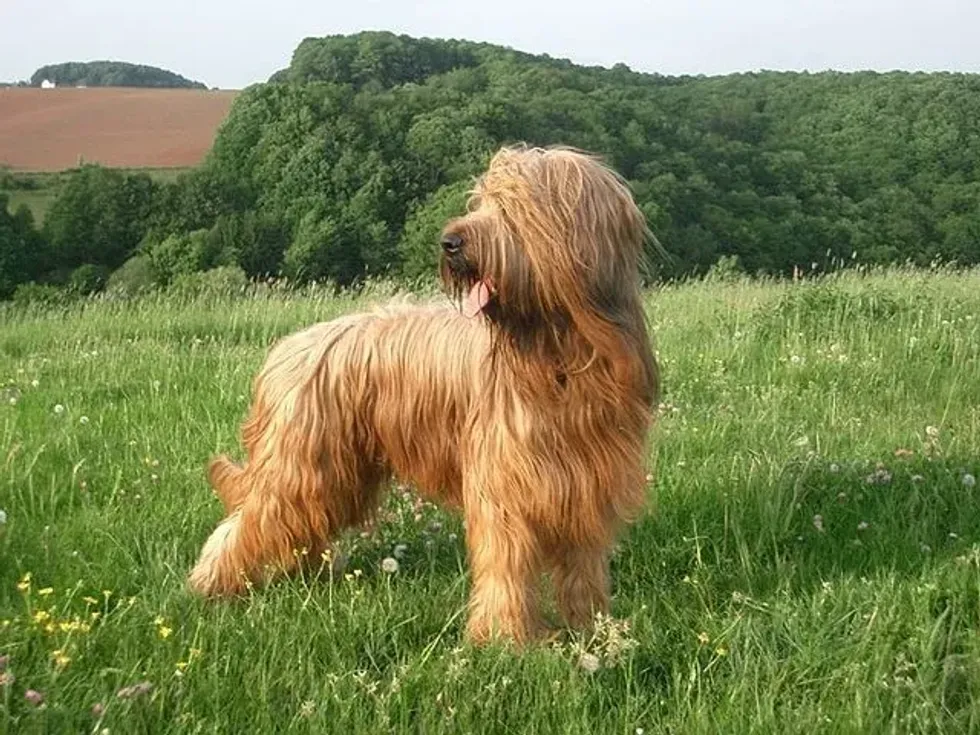Fun Briard Facts For Kids

Briards are intelligent, brave, and loyal dogs. This species is good-natured and flourishes in family activities; the Briard is a great house dog in spite of its large size.
These dogs do not like being alone, they like to spend time with their family members. The Briard can be uncomfortable with strangers, being protective towards their family members as a flock guard. The Briard will bark loudly and alert their master if they see any signs of intruders.
These dogs can be both willful and stubborn but with proper obedience training, they can get accustomed to their surroundings and this characteristic exhibits how they act fearlessly towards any invaders.
Along with their entire body covered with long and wavy hair, their head is also well covered making it naturally part in the middle.
If you liked these true facts about the Briard, then you'll surely like these facts about the Bergamasco sheepdog and Karelian bear dog too!
Briard Interesting Facts
What type of animal is a Briard?
Briards are black, tawny, or grey in color with an impressive head full of hair covering their entire face including the ears and eyes. Briards are robustly built but can move light-footed.
The Briard has all the traits similar to the herding dogs, they are extremely intelligent, which helps in training the Briard puppy to get familiarized with their surroundings. These tireless and large dogs can handle up to 700 sheep at a time as they were earlier used as herding dogs in France.
What class of animal does a Briard belong to?
Briards belong to the mammal class of animals. Having mammary glands to feed their young ones, the presence of the three ear bones, fur or hair, and the neocortex (region of the brain) are what qualifies the Briard as mammals.
Briard (Canis lupus familiaris) belongs to the genus Canis of the dog family Canidae.
How many Briards are there in the world?
An accurate number of Briards is impossible to pinpoint as they have been domesticated all around the world, with breeders contributing to a large number of new additions to the French herding dogs by breeding them as pets.
Where does a Briard live?
In history, the Briard is considered to be the most ancient species of dog breed. This species is native to Northern France where they are also known as Shepherd Dog Brie and Chien Berger de Brie.
Briards were used to carry supplies, medicines, and ammunition to the soldiers during the French and Indian war. These dogs were officially announced as dog breeds of the French army.
The introduction of Briards in the United States was promoted by Thomas Jefferson, the Third U.S. President, in the late 1780s when he purchased a pregnant Briard and brought her back along with him.
What is a Briard's habitat?
Briards are both indoor and outdoor animals and are a great match for households with children, given they are properly supervised. They love to play and, given their size, this species are perfect for a small household. In some cases, the Briard can survive in the wild! Briards are happiest inside the home as family members.
Who does a Briard live with?
The Briard is a people-friendly species. They tend to live with people and do not like to be alone. They are found to be following their masters and protect the other family members.
How long does a Briard live?
The Briard life span mostly depends on its activities, diet, and proper care. These breeds can live up to 10-14 years. Being prone to many health problems such as canine hip dysplasia, progressive retinal atrophy, and gastric torsion might shorten their life span.
How do they reproduce?
The Briard reaches sexual maturity at the age of 18 months. The gestation period for the Briard lasts around 60-63 days after mating. Their litter size is 8-10 puppies.
When the male senses that the female is in heat, he will sniff her vulva, and if the female is receptive, she will hold her tail to the side, allowing the male to mount her and thus engaging in the act of mating.
What is their conservation status?
The conservation status of Briard dogs is currently not enumerated in the IUCN Red List. So, given their huge popularity with great agility, quirky and fun-loving personalities, we can safely assume that their numbers are in abundance.
Further, they are bred all across the globe and can be found in households all over the world. These dogs are perfectly safe and will not be nearing extinction or worrying numbers for a long time!
Briard Fun Facts
What do Briards look like?
The Briard is a muscular and large-sized dog, with a long head with a set of hanging cropped ears. These dogs are known for their appearance having 6 in (15 cm) of long wavy hair all over their body, with long hair on their ears as well.
Their coats can shed dirt and water, which comes in black, grey, and tawny in colors. They have two coats, the outer coat is harsh, coarse, and dry which lies down falling flat, long, and polished hair.
Whereas the undercoat is tight and fine on the entire body. Their head is fully covered with hair making their eyes and ears invisible and they also have two dewclaws on both the rear feet.

How cute are they?
On a scale of 1-10, the Briard scores a 10 out of 10 because of its furry looks and friendly nature. This breed of dogs is kids friendly, they will protect the kids in the family even when their masters are disciplining them.
How do they communicate?
The Briard is known to be one of the most energetic species of dogs, and they bark a lot! They try to make conversation with their owners and will try to nip to communicate!
Like all other breeds of dogs, they communicate through vocalizations and auditory signals like barking, whimpering, growling, panting, and sighs. They also communicate by utilizing scent and pheromones.
How big is a Briard?
A fully grown adult male Briard can grow up to 23-27 in (58.4-68.5 cm) in length and females are slightly smaller growing up to 22-25.5 in (55.8-64.7 cm) in length.
How fast can a Briard run?
Unfortunately, the accurate speed of the Briard has not yet been recorded, but these dogs are swift-movers.
How much does a Briard weigh?
A fully grown Briard can weigh up to 50-100 lb (23-45 kg), males are usually larger than females. The average weight of a female is between 50-77 lb (23-34 kg).
What are the male and female names of the species?
Just like in all dog breeds, a male Briard is called a dog, and a female Briard is called bitch.
What would you call a baby Briard?
A baby Briard is called a puppy. They are born in a litter of 8-10 individuals and look similar to adults.
What do they eat?
The Briard diet consists of high-quality dog food, which can be canned food or homemade food. Briards may also be fond of homemade food and they should be fed twice a day.
Are they slobbery?
No, Briards are not slobbery. In fact, they are the best example of a breed that drools very little.
Drooling is the unintended flow of saliva out of the mouth; while it can be completely normal among a few breeds of dogs, it could also indicate a health concern at times.
If you are someone who typically stays away from animals who drool or leave sweaty paw prints all over your clothes, then Briards are perfect for you as they have minimal drool. Another dog that barely drools is the Old English Sheepdog.
Would they make a good pet?
Yes, Briard can become a good pet as these species can adapt easily to a country and city life, no prior experience is required to handle these dogs.
Briards are a surprisingly calm breed when they are inside the house but if they are bored they might start barking, chewing, and chasing around and they are also extremely energetic when left in the open.
To sharpen their natural herding abilities you need to train and participate in dog sports and the briard can become the best jogging companion of the owners.
Briards need several hours a week for grooming as their extraordinary minimal shedding fur of different colors requires lots of combing and brushing to keep it looking good.
They need to be given a bath every six to eight weeks to keep their fluffy coats clean and sometimes a professional groomer should be hired to maintain their grooming needs. You should brush briards teeth twice or thrice a week to remove the bacteria inside the tartar.
Some other long-haired dogs include the Lhasa Apso, Havanese dog, and the Afghan hound.
Did you know...
Briards were recognized by the AKC (American Kennel Club) in 1928 as its 81st breed on the list, these species are long-lived breeds of French working dogs. As per AKC (American Kennel Club), this breed ranks 132 among other breeds.
In most European countries, ear cropping has become illegal, including France the native place of the briard where they are also known as Berger de Brie.
Although the coat of the briard is judged as low-shedding it requires daily grooming, because their wavy fur can easily get dull and tangled. This breed is one of the original hypoallergenic dogs, making them suitable for families worrying about allergies. Bedlington Terrier, Bichon Frise, and Chinese Crested breeds are considered to have many issues of allergies.
Thomas Jefferson- the third U.S. president- was responsible for the introduction of the briard in the United States.
You can get a Briard puppy at $2000-$5000 USD, you can also adopt these dogs from animal shelters.
A dog owner with a Briard in the house needs to spend time with their pet as these dogs who are even considered a calm breed, can be mischievous if they get bored.
The availability of two dewclaws on both the rear legs gives an appearance of having outspread rear feet.
People tend to get confused when seeing this dog run freely as their eyes are completely covered by their long and wavy hair.
In Pixérécourt's version of Aubry de montdidier, a trained briard was used to play a vital role in the play along with the main character.
Are Briards aggressive?
In the early days, the Briard was used for defending its herding animals from poachers and wolves. This species has an aggressive temperament and prey drive towards the unknown or unfamiliar faces.
Briards are socialized at an early age to avoid aggression towards animals and people they do not know as their prey drive tendency is higher. Briard takes their role as guard dogs extremely seriously.
Is a Briard a good family dog?
Briards are known as 'a heart wrapped in fur', making them great family dogs. These dogs have similar traits to a herding dog species, such as trainability, a protectiveness towards family, brains, and caution towards outsiders.
Briards are playful and loving companions, they prefer to be treated like family members. It is extremely important for the master of these dogs to teach their children how to approach and touch dogs, young children should always be under supervision when playing with these dogs.
Briards should not be disturbed while eating food, as no such dog is less aggressive if you try to take their food away.
Briards should be trained properly as these species might not attack their family members but can chase or tend to become aggressive towards outsiders. This species should always be kept on a leash when outside as they may run after other animals.
Here at Kidadl, we have carefully created lots of interesting family-friendly animal facts for everyone to discover! For more relatable content, check out these lhasapoo facts and labsky facts pages.
You can even occupy yourself at home by coloring in one of our free printable briard coloring pages.
We Want Your Photos!
More for You
See All
Bachelor of Arts specializing in Journalism and Mass Communication, Postgraduate Diploma in Sports Management

Moumita DuttaBachelor of Arts specializing in Journalism and Mass Communication, Postgraduate Diploma in Sports Management
A content writer and editor with a passion for sports, Moumita has honed her skills in producing compelling match reports and stories about sporting heroes. She holds a degree in Journalism and Mass Communication from the Indian Institute of Social Welfare and Business Management, Calcutta University, alongside a postgraduate diploma in Sports Management.
Bachelor of Arts specializing in Economics

Gowri RaoBachelor of Arts specializing in Economics
With a bachelor's degree in Economics from Krea University, Gowri is a highly skilled data analyst and an expert in regression and causation modeling. Her interests in economic trends, finance, and investment research complement her professional expertise. In addition to her professional pursuits, Gowri enjoys swimming, running, and playing the drums, and she is also a talented tutor.
Disclaimer
1) Kidadl is independent and to make our service free to you the reader we are supported by advertising. We hope you love our recommendations for products and services! What we suggest is selected independently by the Kidadl team. If you purchase using the Buy Now button we may earn a small commission. This does not influence our choices. Prices are correct and items are available at the time the article was published but we cannot guarantee that on the time of reading. Please note that Kidadl is a participant in the Amazon Services LLC Associates Program, an affiliate advertising program designed to provide a means for sites to earn advertising fees by advertising and linking to Amazon. We also link to other websites, but are not responsible for their content.
2) At Kidadl, we strive to recommend the very best activities and events. We will always aim to give you accurate information at the date of publication - however, information does change, so it’s important you do your own research, double-check and make the decision that is right for your family. We recognise that not all activities and ideas are appropriate for all children and families or in all circumstances. Our recommended activities are based on age but these are a guide. We recommend that these ideas are used as inspiration, that ideas are undertaken with appropriate adult supervision, and that each adult uses their own discretion and knowledge of their children to consider the safety and suitability. Kidadl cannot accept liability for the execution of these ideas, and parental supervision is advised at all times, as safety is paramount. Anyone using the information provided by Kidadl does so at their own risk and we can not accept liability if things go wrong.
3) Because we are an educational resource, we have quotes and facts about a range of historical and modern figures. We do not endorse the actions of or rhetoric of all the people included in these collections, but we think they are important for growing minds to learn about under the guidance of parents or guardians.







